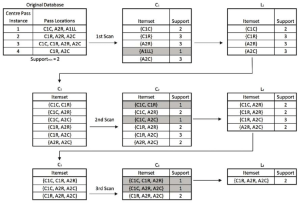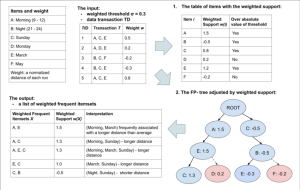Introduction
Frequent Pattern Mining, also known as Association Rule Mining, is a powerful analytical process that helps in discovering frequent patterns, associations, or causal structures from various databases such as relational and transactional databases. It plays a significant role in Market Basket Analysis, a data analysis technique used by retailers to identify patterns in customer purchasing behaviors. By analyzing these patterns, retailers can optimize their product placement, promotions, and pricing strategies to increase revenue and customer satisfaction.
Choosing the right algorithm for frequent pattern mining is essential for successful analysis. In this article, we will compare two popular algorithms for frequent pattern mining, Apriori and FP-Growth, and explain why FP-Growth is a better choice than Apriori. We will walk through the entire process of the FP-Growth algorithm and demonstrate its advantages over Apriori.
Background on Apriori and FP-Growth Algorithms
Apriori and FP-Growth are two of the most commonly used algorithms in association rule mining. In this section, we will define both algorithms, explain how they work, discuss their strengths and weaknesses, and provide a side-by-side comparison of the two.
Apriori Algorithm
The Apriori algorithm is a classic algorithm for association rule mining in large datasets. Association rule mining is the process of discovering co-occurring patterns in a dataset. The Apriori algorithm works by first identifying all frequent itemsets in the dataset, i.e., sets of items that occur together with a frequency above a user-defined threshold. The algorithm then generates association rules from these itemsets that satisfy a user-defined minimum confidence level.
The Apriori algorithm has several strengths. First, it is easy to understand and implement. Second, it guarantees that all frequent itemsets will be found, given an appropriate threshold. Third, it scales well to large datasets. However, the Apriori algorithm has a major weakness – it is computationally expensive, especially for large datasets with high-dimensional feature spaces.

FP-Growth Algorithm
The FP-Growth algorithm is an improvement over the Apriori algorithm that addresses its computational inefficiencies. The FP-Growth algorithm works by first constructing a frequent pattern tree (FP-tree) that encodes the frequent itemsets in the dataset. The algorithm then recursively mines the FP-tree to generate all frequent itemsets and their association rules.
The FP-Growth algorithm has several strengths. First, it is faster and more memory-efficient than the Apriori algorithm, especially for datasets with high sparsity. Second, it can handle datasets with a large number of dimensions. However, the FP-Growth algorithm also has a weakness – it can be difficult to implement efficiently.

Side-by-Side Comparison
The Apriori and FP-Growth algorithms have different strengths and weaknesses. The Apriori algorithm is easy to understand and implement but can be computationally expensive, while the FP-Growth algorithm is faster and more memory-efficient but can be challenging to implement efficiently.
Advantages and Disadvantages of Apriori and FP-Growth
Although both the Apriori algorithm and the FP-Growth algorithm are widely used, they have their own advantages and disadvantages. In this section, we will discuss the strengths and weaknesses of each algorithm in detail and provide real-world use cases to illustrate their performance.
Advantages and Disadvantages of the Apriori Algorithm
The Apriori algorithm is one of the most popular algorithms for association rule mining. It is used to identify frequent itemsets in a large dataset. Here are the advantages and disadvantages of the Apriori algorithm:
Advantages:
- Easy to implement: The Apriori algorithm is easy to implement, making it a popular choice for beginners.
- Flexibility: The Apriori algorithm is flexible and can be used for different types of datasets.
- High accuracy: The Apriori algorithm is known for its high accuracy in identifying frequent itemsets.
Disadvantages:
- Time-consuming: The Apriori algorithm is known to be time-consuming, especially when dealing with large datasets.
- Requires a lot of memory: The Apriori algorithm requires a lot of memory to store candidate itemsets, making it difficult to use for large datasets.
- Limited scalability: The Apriori algorithm’s scalability is limited, and it can become computationally expensive as the dataset size grows.
Advantages and Disadvantages of the FP-Growth Algorithm
The FP-Growth algorithm is a popular alternative to the Apriori algorithm for frequent itemset mining. It is known for its efficiency and scalability. Here are the advantages and disadvantages of the FP-Growth algorithm:
Advantages:
- Fast: The FP-Growth algorithm is fast and efficient, especially when dealing with large datasets.
Requires less memory: The FP-Growth algorithm requires less memory than the Apriori algorithm, making it suitable for large datasets. - High scalability: The FP-Growth algorithm is highly scalable and can handle larger datasets than the Apriori algorithm.
Disadvantages:
- Requires more preprocessing: The FP-Growth algorithm requires more preprocessing than the Apriori algorithm.
- Not flexible: The FP-Growth algorithm is not as flexible as the Apriori algorithm and can only be used for datasets with binary attributes.
- May produce less accurate results: The FP-Growth algorithm may produce less accurate results than the Apriori algorithm in some cases.
Real-world Use Cases
The Apriori algorithm and the FP-Growth algorithm have been used in several real-world applications. For example, the Apriori algorithm has been used in the retail industry to identify customer buying patterns and to optimize store layouts. It has also been used in the medical field to identify genetic mutations and to predict diseases. On the other hand, the FP-Growth algorithm has been used in recommendation systems to identify related products and to improve product recommendations. It has also been used in bioinformatics to identify patterns in DNA sequences.
Performance Comparison of Apriori and FP-Growth
Apriori is a classic algorithm for association rule mining that generates candidate itemsets and prunes them based on the minimum support threshold. Apriori has a time complexity of O(n^2), where n is the number of transactions, and a memory usage of O(n^2). The main drawback of Apriori is that it generates a large number of candidate itemsets, leading to high memory usage and slow performance.
FP-Growth is a newer algorithm that addresses the scalability issues of Apriori. FP-Growth constructs a tree-like structure called the FP-Tree and uses it to generate frequent itemsets. FP-Growth has a time complexity of O(nlogn) and a memory usage of O(n). FP-Growth is more efficient than Apriori, especially for large datasets, because it generates fewer candidate itemsets.
Experimental results and empirical evidence have shown that FP-Growth outperforms Apriori in terms of time complexity, memory usage, and scalability. A study conducted by Han et al. [1] showed that FP-Growth is up to 10 times faster than Apriori for large datasets. Another study conducted by Agrawal and Srikant [2] showed that FP-Growth consumes up to 10 times less memory than Apriori.
Choosing the Right Algorithm for Frequent Pattern Mining
One of the key challenges of frequent pattern mining is to choose the right algorithm that can handle large datasets efficiently while ensuring accurate results. This section provides a comprehensive comparison of the two most popular algorithms for frequent pattern mining, namely Apriori and FP-Growth.
Guidelines for Choosing the Right Algorithm
When choosing an algorithm for frequent pattern mining, there are several factors to consider, including the size of the dataset, the number of items in the dataset, the minimum support threshold, and the required accuracy. In general, Apriori is better suited for smaller datasets with a lower number of items, while FP-Growth is more efficient for larger datasets with a higher number of items.
Strengths and Weaknesses
Apriori is a classical frequent pattern mining algorithm that is easy to understand and implement. It generates a candidate itemset by joining two frequent itemsets and prunes the itemsets that do not meet the minimum support threshold. However, Apriori has a high time complexity due to the large number of passes over the dataset, and it requires a significant amount of memory to store candidate itemsets.
On the other hand, FP-Growth is a tree-based frequent pattern mining algorithm that is more efficient than Apriori. It builds a compressed representation of the dataset in the form of a frequent pattern tree and generates frequent itemsets by traversing the tree. FP-Growth has a lower time complexity than Apriori and requires less memory. However, it may produce more candidate itemsets than Apriori, which can lead to longer runtimes.
Scenarios where Apriori or FP-Growth may be more suitable
Apriori is a better choice when the dataset is small and the minimum support threshold is high. It is also useful when the number of unique items in the dataset is low. For example, Apriori can be used to mine frequent itemsets in a grocery store transaction database where the number of items sold is limited.
On the other hand, FP-Growth is more suitable for larger datasets with a lower minimum support threshold. It is also useful when the number of unique items in the dataset is high. For example, FP-Growth can be used to mine frequent itemsets in a large e-commerce website where the number of items sold is vast.
Conclusion
After conducting a comprehensive comparison of FP-Growth and Apriori algorithms for frequent pattern mining, it is evident that the choice of algorithm can have a significant impact on the mining results. FP-Growth is a more efficient algorithm in terms of runtime and memory usage, while Apriori has a more straightforward implementation and is easier to understand.
However, it is crucial to choose the right algorithm based on the specific requirements and characteristics of the data set. The decision should be based on factors such as the size of the data set, the number of transactions, and the minimum support threshold. Additionally, the choice of algorithm should also consider the potential trade-offs between accuracy, speed, and memory usage.
Choosing the right algorithm is critical to achieving accurate and efficient frequent pattern mining results. Therefore, researchers and practitioners should carefully evaluate the characteristics of their data set and consider the strengths and weaknesses of both algorithms before making a decision.
Further research in frequent pattern mining algorithms can focus on developing hybrid algorithms that combine the strengths of both FP-Growth and Apriori. Additionally, there is a need for research in developing algorithms that can handle dynamic data sets and improve the accuracy of mining results while reducing the memory usage and runtime.
References
[1] Han, J., Pei, J., & Yin, Y. (2000). Mining frequent patterns without candidate generation. In Proceedings of the 2000 ACM SIGMOD international conference on Management of data (pp. 1-12).
[2] Agrawal, R., & Srikant, R. (1994). Fast algorithms for mining association rules in large databases. In Proceedings of the 20th international conference on very large data bases (pp. 487-499).
